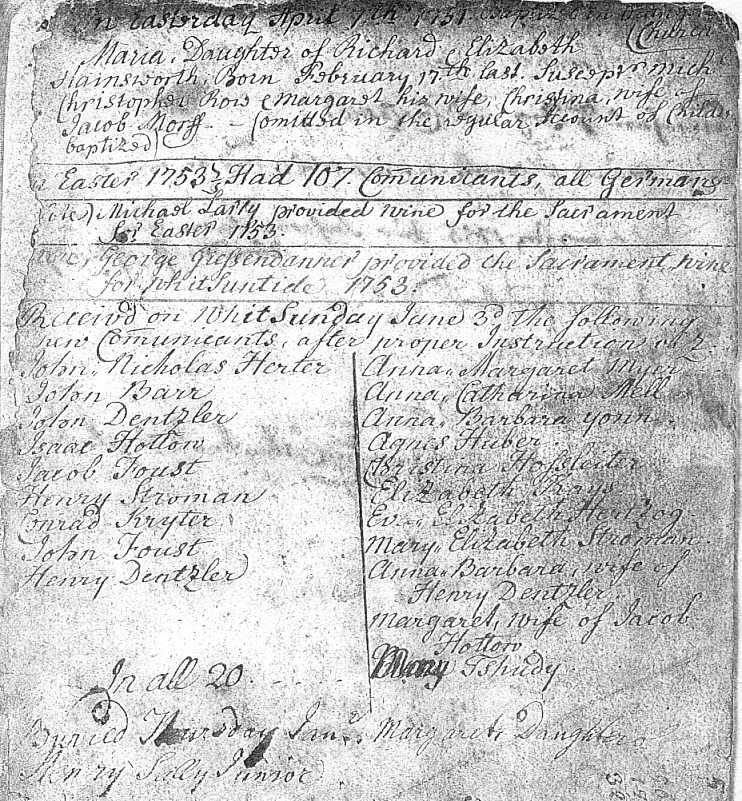|
|
|
Emblem of Canton Glarus, |
|
|
|
Emblem of Canton Glarus, |
Margaret (1Martin) Tshudy
The last child of Martin and Ann Catherine is know as either Lydia Margaret or Margaret. Family history states that Margaret Tshudy married Jacob Hutto b. 1736 Orangeburg Co SC. The question is finding documentation.
Researchers of Orangeburg Co., South Carolina, truly benefit from the records compiled by Rev. Giessendanner and his nephew at St. Matthew's Church. These volumes record marriages from October 1737 through 1768, baptisms from December 1739 through 1761, and deaths from February 1750 through 1761. And, many lineages have been documented from this original source <http://www.xs4all.nl/~sail/orange/a-index.html>.
Martin and Ann Catherine's immigration date (1735) establishes the earliest possible date for Margaret's birth; as Martin and Ann Catherine immigrated with their first four children and were granted 300 acres of land [50 acres x 6 heads]. Considering the beginning date of the Giessendanner baptism record (Dec 1739), we can establish the latest possible date for Margaret's birth. If Margaret existed at all--I believe this is true--her date of birth can be set circa 1737.
Margaret Tshudy married Jacob Hutto c. 1753 at about age 16. However, this cannot be proven; as their marriage is not part of the Giessendanner Record. Many researcher have cited Anna Margaretta Dietrick as Jacob's wife. However, Anna was baptized 9/14/1741, and "Margaret, wife of Jacob Hottow" received First Communion on 6/3/1753. This would require Anna to have been married by age 11.
| 1741 Sept. 14 baptized privately Anna Maria Margaretta Diedricks, leg. child of Mr. Johannes Diedricks and his wife, Sponsors Henry Wuertzer, Peter Hurger, Margret Koenig, formerly Hessig, and Margareta Laehryig, formerly Bodenerig. (Rev. Giessendanner) |
The question is, "Why would Margaret receive First Communion after marriage?" We know the children born in Switzerland were baptized prior to emigration. Did the Tshudy Family attend the local German Language Lutheran church in Orangeburg only for marriages, baptisms, and funerals? Were the Tshudys Swiss Anabaptists instead of Lutherans? The literal change of Form and language in the Giessendanner Record after Rev. Giessendanner's installation as an Episcopal priest gives us a clue.
Rev. Hans Ulrich Giessendanner, the Elder, began preaching a variant of Swiss Reform Calvinism long before migrating to America. In fact, disapproval of his preaching was a major cause for his leaving Switzerland. Upon arrival, the Elder Giessendanner was nominated by the community to serve as minister. And, he preached his individual style of Calvinism until his death in about 1738, preaching in the Swiss German dialect and following a variant of the Lutheran Rite.
Rev. John Giessendanner, the Younger, took up the mantle as minister at age 18, continuing his uncle's work as minister. However after externally imposed turmoil, he went to Charles Town in 1738 for ordination in the Church of England. Whether by influence or coercion, he was sidetracked and presented to the Presbytery of South Carolina where he was ordained a Presbyterian minister. This would have necessitated change in Form and Rites in the local church.
In May 1749 Rev. Giessendanner, The Younger, went to England to be ordained an Episcopal priest. Observable in the Giessendanner record are instances of English and Latin interspersed with German prior to his departure. Some have conjectured that the Younger was improving his education as preparation for ordination. Upon his return, notations in the record change from German to English with Latin instructions. Additionally, Joop Giessendanner cites that maiden names were eliminated in accordance with the Episcopal Form as opposed to the German tradition. By changing the Form of Worship again, were some German immigrants eliminated from cross-communication, requiring Episcopal instruction and First Communion for acceptance into the church?
So, why would Margaret receive First Communion after marriage? A simple answer would be that Jacob and Margaret eloped, and the families made them execute the Forms of Episcopacy, including Margaret's First Communion.
Very little is known of Margaret Tshudy. If she was Jacob's first wife, she died before 5/1759. Proof of the eventual marriage of Margaret Diedricks and Jacob Hutto is found in the 1759 will for Grandfather Johannes Diedricks who left land to his "Beloved grand daughter Margaret now the wife of Jacob Hottow of Orangeburg."
Born c. 1737 Orangeburg Dist. SC
Married before 6/1753 in Orangeburg Dist. SC to Jacob Hutto b. 1737 Orangeburg Dist. SC
First (Episcopal) Communion 6/3/1753
|
Note: George Giessendanner provided the Sacrament Wine for Whitsuntide 1753 |
Received on Whitsunday June
3d the following |
|
 |
John Nicholas Herter John Barr John Dentzler Isaac Hottow Jacob Foust Henry Stroman Conrad Kryter John Foust Henry Dentzler In all 20 . . . . |
Ann Margret Myer Anna Catharina Mell Anna Barbara Yonn Agnes Huber Christina Hossleiter Elizabeth Kays Eva Elizbth Hertzog Mary Elizabeth Stroman Anna Barbara, wife of Henry Dentzler Margaret, wife of Jacob Hottow Mary Tshudy |
Died before 5/1759 Orangeburg Dist. SC
| Charleston Will Book RR 1767-1771, p. 298: Will of Hans Dietrick. Hans Dietrick left his estate to his widow Anna. Residual legatees were : Beloved grand daughter Margaret now the wife of Jacob Hottow of Orangeburg Ex: Peter Roth. Wit: Samuel Luther, George Frazler, John Endel. Signed 15 May 1759, proven 3 Mar 1769. |